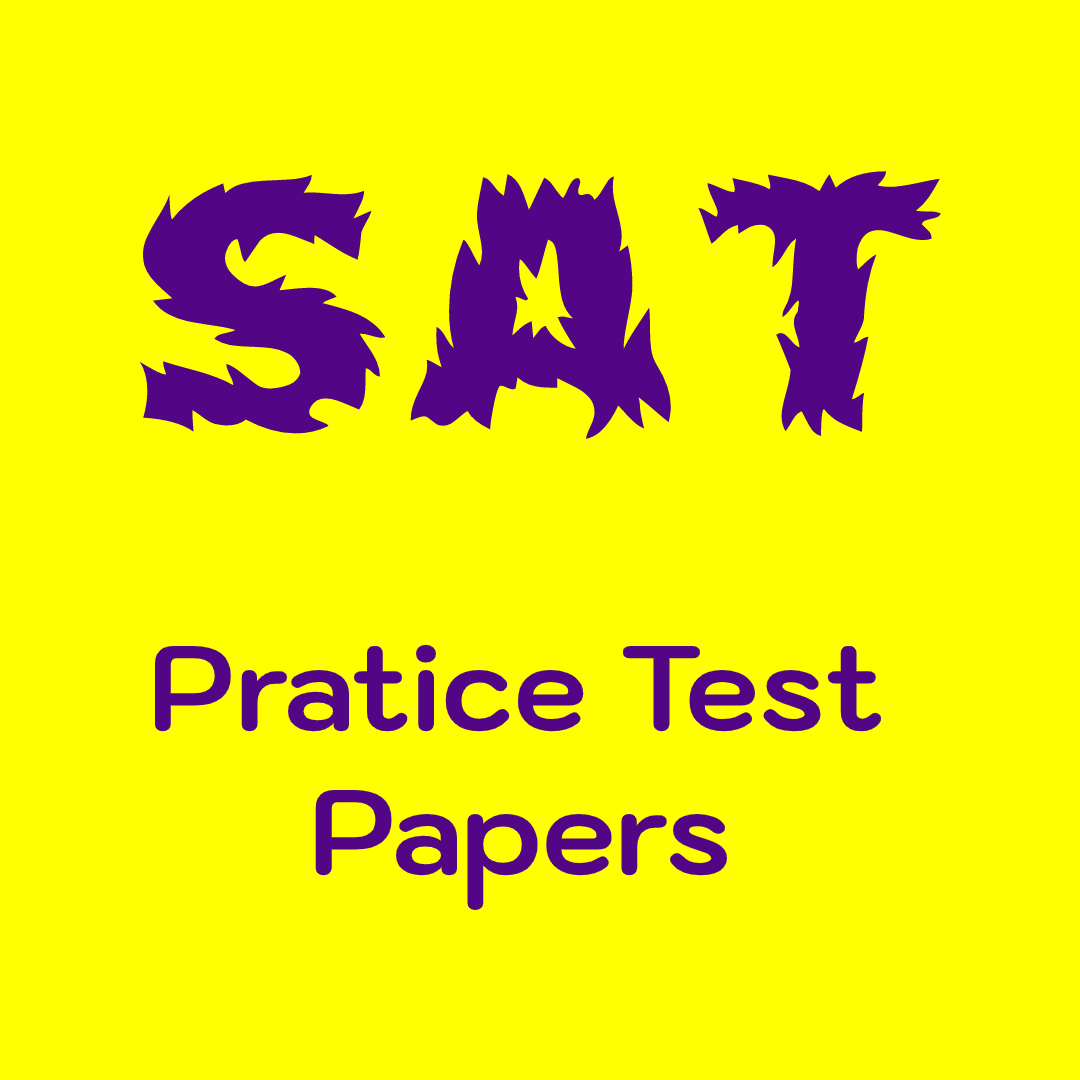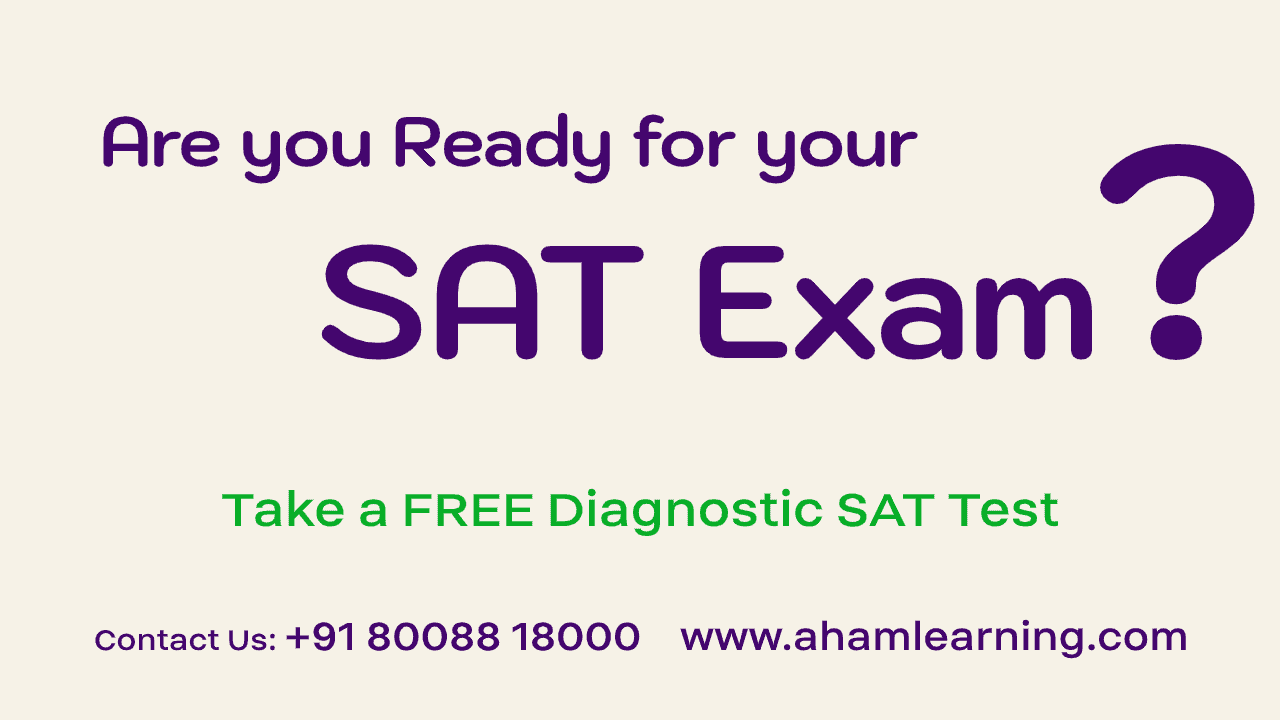Free SAT Diagnostic Tests
Explore the Aham learning’s free diagnostic tests for SAT to determine which academic concepts you understand and which ones require your ongoing attention. Our free SAT practice tests are the perfect way to brush up your skills. Each SAT problem is tagged down to the core, underlying concept that is being tested.
The SAT diagnostic test results highlight how you performed on each area like Reading; Writing; and Math of the test. You can then utilize the results to create a personalized study plan that is based on your particular area of need.
scoring results at the end of your SAT practice test to help you identify your strengths and weaknesses. Pick one of our SAT practice tests now and begin!
What is the SAT?
The SAT is a standardized test used by colleges to help them evaluate potential students. It is intended to measure a student’s ability and readiness for college courses in three subject areas: Reading; Writing; and Math. Whether you need SAT tutoring in Atlanta, SAT tutoring in Houston, or SAT tutoring in San Francisco, working one-on-one with an expert may be just the boost your studies need.
How do I prepare for the SAT?
Our Experienced Tutors offers free SAT Practice Tests for you to use in preparing for the SAT. Our free SAT Practice Tests are written by teachers, professors, content specialists, and tutors. There are Full-Length SAT Practice Tests available for each section of the test. Each of these complete practice tests can help you get better idea of your current level of knowledge and recover your skill.
They can also assist you in creating an individualized study plan that meets your needs for your next SAT Test. The results page that follows the test will tell you which concepts you already understand, and which concepts need some additional review.
The results page also offers tons of information you can fit into your study plan, like step-by-step explanations of the correct answers and links that provide key concept review. When you’re ready, you can return to take another Full-Length SAT Practice Test to gauge your progress and refine your study plan. In addition to the SAT practice tests and SAT tutoring, you may also want to consider checking out our SAT question of the day.
Also Read:
SAT Exam Preparation Dates Center Eligibility 2020
SAT Exam Preparation Tips | Start Preparing for SAT exam NOW

How much does it cost to take the SAT fro Indian Applicants?
The basic fee for the exam is $52, but it varies based on the country of the applicant. For Indian applicants, the fee for SAT comes out to be ~$106 (with written essay), or ~$94 (without essay).
In Indian Rupees, the SAT exam fee is around 6200-7500 INR. (As per Oct 2019 Records)
Find more details for fee structure here
When can I take the SAT?
It is possible to take the SAT in October, November, December, March, May, and June. The SAT is given once during each of these months. You can take the test as many times as you like, but it is most common for students to take the SAT twice: once at the end of their junior year of high school, and once at the beginning of their senior year of high school.
Are the SAT’s sections always given in the same order?
Yes, the SAT always gives its sections in the same order. The Essay section is always first; it is followed by two multiple-choice Writing sections, three multiple-choice Critical Reading sections, three multiple-choice Mathematics sections, and finally one ungraded multiple-choice section that varies in content.
Our free SAT Practice Tests allow you to study what you need to study when you need to study it, so you don’t have to stick with the order of the official SAT test if you don’t want to.
What materials can I bring with me when I take the SAT?
- Photo ID (current school ID, driver’s license, or passport are the most common)
- Printed admissions ticket
- Several freshly sharpened no. #2 pencils with good erasers
- A small pencil sharpener
- An extra eraser
- A calculator with new batteries (certain calculator models are restricted)
- Extra batteries
- A watch (with NO alarms set)
- Snacks and drinks (ONLY for your allotted breaks)
It’s a good idea to keep this checklist handy, and to gather up the materials early. Students should be able to focus on the important things, like pumping themselves up for the test, while also being well-prepared.
How is my SAT Score calculated?
For each question on the test students receive 1 point for a correct answer, lose ¼ of a point for each incorrect answer, and receive 0 points for questions left blank.
The SAT has two required sections: ERW and Math. We score each section on a scale of 200–800, so when you take the test, you’ll get two section scores—one for ERW and one for Math.
You’ll also get a total score. This is your ERW score plus your Math score. Total scores range from 400 to 1600.
Free Printable SAT Tests (Current 1600 Format, 2016-Present)
Currently, there are 10 available practice tests for the redesigned SAT, all of which have been provided by the maker of the SAT itself, the College Board. These tests are the absolute best ones to use for your SAT studies since they’re the most similar to the test.
When and how will I find out how I did on the SAT?
Generally, students find out how they performed on the SAT about two or three weeks after taking it. Scores can be accessed online or through your school, or they’ll be sent in the mail. If you choose to have your scores sent in the mail, be aware that it will take longer for you to receive your scores than if you accessed them online.
Here’s an overview of the official time limits for each SAT section as well as how long you should spend (roughly) per question:
| SAT Section | Time | # of Questions | Time per Question |
| Reading | 65 minutes | 52 | 75 seconds |
| Writing and Language | 35 minutes | 44 | 48 seconds |
| Math No Calculator | 25 minutes | 20 | 75 seconds |
| Math Calculator | 55 minutes | 38 | 87 seconds |
What changes are being made to the SAT in 2016?
1. SAT will revert to 1600 point scale
Old: The old SAT has three sections: Math (800), Critical Reading (800) and Writing (with an essay) (800) for a total of 2400 points.
New: The new SAT will have two sections: Math (800) and Evidence-Based Reading & Writing (including Reading section and Writing & Language section) (800) for a total of 1600 points.
2. The essay is now optional instead of being required
Old: The old SAT requires one essay scored out of 12 and factored into the Writing section score. It will typically ask the student a broad question based on a very short paragraph and ask the student to take a stance and support it. It was also presented as the first section for 25 minutes.
New: The new SAT has an optional essay which will be scored separately. It will ask the student to analyze a 650-750 word document and draft an essay analyzing it. It is presented as the last section for 50 minutes.
3. Computer versions are now available
Old: The old SAT has only paper version.
New: The new SAT has both digital and print versions.
4. No penalizing for guessing
Old: Students receive ¼ point reduction for wrong answers but no points deducted for omitting answers.
New: No penalizing for incorrect answers so guess your heart away!
5. Reduction in answer choices
Old: The old SAT has five answer choices to choose from.
New: This improved test will have just four answer choices.
CONTENT CHANGES
1. Students must now use evidence to support their answers
Old: Students choose answers to show they understand the text but are not asked to support their answers.
New: The new test will ask students to support their answer with evidence and cite specific passages.
2. More commonly used vocabulary
Old: The old SAT focuses on more obscure (and hence, difficult) words that are not commonly used in varied disciplines and contexts. Think: abjure and harangue. This was mostly used during the Sentence Completion section.
New: The new SAT promises to focus on words that will be “widely used” during college and in one’s career. Think: synthesis or empirical. There will be no Sentence Completion section.
3. More “real life” application
Old: The old SAT does not have any charts, graphs or pictures related to text in the Critical Reading or Writing Section. Furthermore, the math section has straight forward computation questions with a limited number of graphs.
New: The new SAT will feature the aforementioned to test the student on graphical analysis when reading prose. In addition, the math section will require students to apply quantitative skills to real life scenarios as seen in science, the social sciences or humanities.
4. No calculator (sort-of)
Old: Calculators are permitted for all sections.
New: Calculators are permitted only for 37 questions and not permitted for 20 questions out of 57 questions.
5. Less math topics with more emphasis on Algebra
Old: The old SAT focuses on a wide range of topics with more emphasis on computing (i.e. plug and chug).
New: The new SAT focuses on “problem-solving and data analysis” with math being at “the heart of algebra”. Assume that the Math will increase more in difficulty and focused on more advanced skills than previously.
We are dedicated to bringing you the very best practice tests and study guides to help you prepare for and pass the SAT test that stands between you and the rest of your life.
Recommend to Read:
What Is a Good SAT Score? Tips to Improve Your SAT Test Score
Top Experts Share their effective ideas and suggestions for SAT Preparation for High Score
How do I get 1550+ score — SAT Test Prep help for Indian Students
SAT Subject Test for Physics with FREE Practice Tests — Aham
How to Crack the SAT Test? Tips from Experts
Free Official SAT Practice Test — SAT Preparation Guidance
Top Experts Share their effective ideas and suggestions for SAT Preparation for High Score

